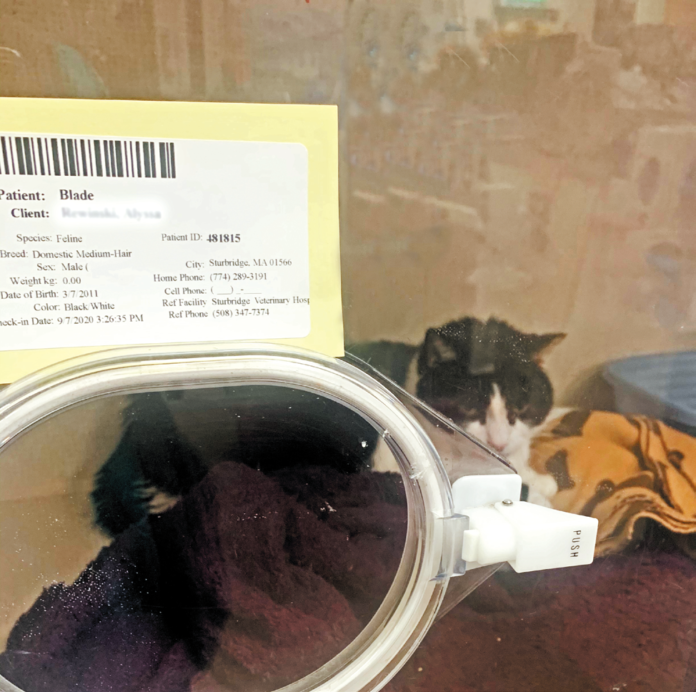If you’ve ever watched a primetime television hospital drama, you know that “Code Blue” means someone has gone into cardiac arrest. She has died on the table because her heart has stopped beating, and she needs immediate assistance in the form of CPR to bring her back to life. In comes the crash cart.
But at many veterinary hospitals, particularly at referral hospitals that have intensive care units like the one at Tufts, any one of three color codes may be in order: Code Red, Code Yellow, or Code Green. And it’s up to you, the cat’s guardian, to decide which it’s going to be. It comes down to how aggressive you want the veterinary team to be in working to save your pet should she stop breathing or her heart stop beating. Just as in human medicine, it is wise to think ahead of time — before the crisis develops.
Here’s how to consider it.
Code Red. This is a DNR — a Do Not Resuscitate order. With people, “there’s often a tendency to be as aggressive as you can no matter what,” says Tufts emergency and critical care veterinarian Armelle de Laforcade, DVM. But if you have, say, an old cat with cancer whose quality of life is diminishing rapidly, you might feel, ‘How fair is CPR?’ It’s a lot to put a cat through if the quality of life you hope to return her to is no better than before — and will only get worse.”
People with cats for whom CPR has a relatively good chance of success may still opt for a Code Red, Dr. de Laforcade says. “Some people struggle to afford care to begin with,” she notes. If a cat comes back to life with CPR, “it probably means a somewhat longer, somewhat more expensive, hospital stay, and an owner can very legitimately feel, ‘This is out of my league. I really can’t do this.’” As long as you love and take good care of your cat from the moment you bring her home until the moment she takes her last breath, you don’t have to feel guilty — it is okay to allow a natural death.
Code Green. This is equivalent to a Code Blue for people, meaning an all-out effort to bring a cat back. Code Green might be the right choice for a healthy cat who was hit by a car but was fine that morning — all the vital organs remain in good shape. “That’s a case where we may want to be aggressive because the animal’s chances of being resuscitated and going on to live an uncompromised life are actually pretty good,” Dr. de Laforcade says.
But there’s a flip side to a Code Green. “The hardest situation for a veterinarian is people saying they want CPR for a pet who should not have it. A good example would be a geriatric cat who has had a cardiac arrest resulting from an advanced, serious disease that cannot be cured. Even if an initial CPR is successful, the pet is likely to experience a second cardiac arrest in the very near future. The person is struggling with saying good-bye” when the good-bye is imminent even if the cat does survive the cardiac arrest, Dr. de Laforcade comments.
Code Yellow. This one is often the best option, the doctor says. It means the veterinarian starts CPR (giving drugs to try to make the heart start up again and beginning chest compressions to create some blood flow) and calls the owner. “For me as a criticalist,” Dr. de Laforcade, says, “in my perfect world, I start CPR, make an assessment of how likely it is to work [there are no guarantees], and then talk with the owner so she can make an informed decision about whether to proceed and, if so, how aggressively. The owner might ask, ‘Do you think we have a chance of getting her back?’ And I can respond, ‘It looks like it might work,’ or ‘We’ve already been at it for an extensive period of time….’”
Does every hospital patient need a code?
If your cat is in the hospital but not in an Intensive Care Unit, chances are she’s probably not going to stop breathing. She’s most likely there for something routine. But for those cats admitted into an intensive care unit or who come in severely ill or physically traumatized, it’s worthwhile to be aware of the code choices. And it’s best to have a conversation with the veterinarian about your decision before the cat has an event during which she stops breathing. Then, when a yellow or green or red sticker is placed on your cat’s cage, you can feel confident that you made the call with as cool a head as possible.




